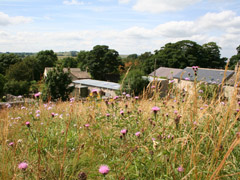
Grindlow from Grind Low |
History of GrindlowA surprising amount of Grindlow's history has been unearthed. There are 2 bronze age burial mounds near the footpath to Foolow. By medieval times Lilleshall Abbey, Shropshire had a monastic grange here with a cemetery and chapel dedicated to St. Mary. At one point it required only a canon and a single shepherd but the real wealth lay in the lead deposits much needed for monastic roofs. In 1538 William Cavendish acted for Henry VIII at the dissolution of the monasteries and this eventually resulted in Grindlow being gifted to him by Edward V1. William was the 3rd husband of Bess of Hardwick and their grandson William became the owner and so Grindlow formed part of his Welbeck estate. William employed William Senior to record his possessions and his original map of 1631 gives the first clear picture of the area; Grind Low forms a rough village green to a more nucleated settlement but otherwise little differs. In the mid 17th century Sir John Harpur of Swarkestone purchased Grindlow and from his widow it passed to the Cokayne family of Rushton, Northamptonshire where it remained until the early 19th century. This period saw the development of a very busy lead mining industry. In 1878, with mining now crippled by foreign competition, various parties put "Grindlow Township" up for auction; sale documents give another clear impression of the place. |
Web page maintained by webmaster and hosted at Conformance Ltd, Great Hucklow. Last updated 20 October, 2006 .